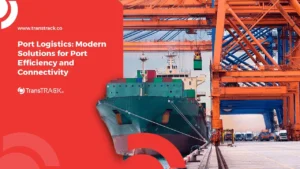Effective Strategies to Improve Fleet Safety in Your Company
Posted on May 22, 2025 by Nur Wachda Mihmidati

In fleet operations, safety is not just a matter of complying with traffic regulations-it involves business continuity, asset protection, and responsibility for driver safety on the road. Fleet safety is a crucial aspect that must be considered by every company that manages operational vehicles, whether in the logistics sector, public transportation, distribution, to mining and field services.
The high number of accidents involving commercial vehicles shows that operational risks can occur at any time, especially if there is no proper monitoring and prevention system. Therefore, a comprehensive strategy and the support of modern technology are needed to ensure that every trip is safe, efficient, and controlled.
This article TransTRACK will discuss the factors that affect fleet safety, strategies to improve it, and the latest technology that can help companies implement fleet safety optimally.
What is fleet safety?
Fleet safety is a set of policies, procedures, technologies, and practices designed to ensure the safety of drivers and vehicles in a fleet – be it a logistics, passenger transportation, distribution, or field service fleet.
Why is fleet safety important for companies?
Fleet safety is very important for companies because it concerns not only the safety of employees, but also the sustainability of the business as a whole. Here are the main reasons why fleet safety is an important priority:
1. Protecting the Life and Health of Drivers
Driver safety is a company’s moral and legal responsibility. Road accidents can cause serious injury or even death.
2. Reduced Operational Costs
- Accidents mean vehicle repair costs, medical expenses, insurance claims, and loss of productivity.
- A good fleet safety program lowers these risks, thereby reducing unnecessary expenses.
3. Increase Productivity and Efficiency
Drivers who feel safe and whose vehicles are well-maintained will work more efficiently and on time. This improves the company’s service reliability.
4. Reduce Legal and Compliance Risks
Companies that neglect fleet safety may face legal sanctions, fines, or revocation of operating licenses for violating work or transportation safety standards.
5. Improving Company Reputation
A company committed to safety has a positive image in the eyes of clients, business partners and the community. This can be an added value in business competition.
6. Optimizing the Use of Technology
By utilizing technology-based fleet safety systems (such as telematics, dashcams, and AI analytics), companies can:
- Detect risky driving behavior in real-time
- Prevent incidents before they happen
- Provide data-driven training
If your company manages a fleet of vehicles, fleet safety is not an option-it’s a necessity.These initiatives help protect a company’s most valuable assets: people, vehicles, and business reputation.
What are the factors that affect fleet safety?
Here are the main factors that affect fleet safety:
1. Vehicle Condition
- Regular checks and maintenance are essential to ensure the vehicle is in roadworthy condition.
- Important components such as brakes, tires, lights, and steering systems must function optimally.
- Damage or negligence in maintenance can lead to serious accidents.
2. Driver Behavior
- Drivers who are untrained, drive aggressively, or are tired are particularly at risk.
- Using a cell phone while driving, breaking traffic rules, or not wearing a seat belt increases the likelihood of an accident.
- Regular safety training and driver behavior monitoring systems are required.
3. Road Conditions
- Broken, slippery or potholed roads can be hazardous to vehicles and drivers.
- Inclement weather such as heavy rain, fog and flooding reduces vehicle visibility and control.
- Congestion and heavy traffic conditions also increase the potential for incidents.
4. Enabling Technology
- The use of GPS, telematics devices and safety sensors helps identify risks early.
- Systems such as dashcams, lane departure warning, brake assist, and driver fatigue detection greatly support safety efforts.
- Technology enables real-time fleet monitoring and data-driven decision-making.
Strategies to Improve Fleet Safety
The following are strategies to improve fleet safety that can be implemented by companies systematically and sustainably:
1. Driver Training
- Provide regular training on driving safety, defensive driving, and risk management.
- Include training on the use of safety technology and how to respond to emergencies.
- Evaluate driver performance regularly to improve awareness and skills.
2. Vehicle Inspection
- Conduct regular inspections before and after the trip.
- Focus on critical components such as brakes, tires, lights, oil and steering system.
- Record and follow up on inspection findings to prevent damage or accidents.
3. Monitoring Driver Behavior
- Use telematics systems to monitor speed, sudden braking, acceleration and driving habits.
- Provide feedback and coaching based on real data.
- Identify at-risk patterns early for timely intervention.
4. Crash Warning System
- Install devices such as dashcam, proximity sensor, lane departure warning, and brake assist.
- These systems help prevent accidents by providing warnings to drivers in real-time.
- Integrate this system with the fleet control center for live monitoring.
5. Use of Safety Checklist
- Use a daily checklist to ensure the driver and vehicle are ready to operate safely.
- Checklists can include vehicle condition, vehicle documents, safety equipment, and driver physical readiness.
- Discipline in the use of checklists helps establish a culture of safety in fleet operations.
Technologies to Improve Fleet Safety
Here is a list of technologies that can be used to improve fleet safety in fleet operations:
1. Advanced Driver Assistance Systems (ADAS)
- Advanced driver assistance systems that include features such as lane departure warning, forward collision warning, and automatic emergency braking.
- Help reduce the risk of accidents by providing early warnings or intervening automatically when necessary.
2. Driver Monitoring System (DMS)
- Technology that monitors the driver’s condition and behavior in real-time, such as fatigue, distraction, or lack of focus.
- Using cameras and sensors to detect signs of danger, and provide immediate warnings to the driver or control center.
3. GPS Tracking
- A real-time vehicle position tracking system that allows companies to monitor routes, speeds and travel times.
- Helps ensure drivers stay on safe and scheduled routes, and facilitates quick response in emergency situations.
4. Telematics System
- Collects and transmits vehicle data such as speed, fuel consumption, acceleration, sudden braking, and engine usage.
- This data is used for safety analysis, driver performance assessment, and optimization of fleet operations.
5. Dashcam and Vehicle Sensors
- The dashcam records activities inside and outside the vehicle for documentation and evaluation.
- Vehicle sensors such as blind spot sensors, parking sensors, and proximity alerts assist drivers in high-risk maneuvering situations.
- This combination of visual and sensory enhances accident monitoring and prevention.
Tips for Choosing the Right Fleet Safety System
Here are tips for choosing the right fleet safety system for your company:
1. Tailor to Operational Needs
- Identify the most common fleet types, routes, trip frequencies, and risks in the field.
- Choose a system that is relevant for your business context, whether it is logistics, distribution, mining, or public transportation.
2. Prioritize Key Safety Features
- Make sure the system includes features such as GPS tracking, driver behavior monitoring, telematics, and crash alerts.
- Additional technologies such as ADAS, DMS, and dashcam can be a significant plus.
3. Look for Ease of Integration
- Choose a system that can be integrated with your existing fleet management system or ERP.
- Good integration makes reporting, data analysis, and decision-making easier.
4. Choose an Easy to Use Platform
- The interface should be intuitive and easy to understand for fleet managers and drivers.
- Ensure adequate training, technical support, and documentation are available.
5. Ensure Real-Time Support and Data Analytics
- Choose a system that provides real-time monitoring as well as automated reports and analysis of fleet and driver performance.
- This data is important for evaluation, training, and improving safety policies.
6. Check Reputation and After-Sales Service
- Check other users’ reviews and the reputation of the system provider.
- Make sure there is after-sales support, system updates, and quick response to technical glitches.
7. Calculate Long-term Cost Efficiency
- Consider the long-term value of the investment versus the cost of accidents, repairs, and lost productivity.
- Systems that seem expensive upfront can actually save you a lot in the long run.
Fleet safety is not just an obligation, but a strategic investment to maintain operational sustainability, company reputation, and most importantly-the safety of human resources. By implementing the right strategies and optimally utilizing supporting technologies, companies can significantly reduce the risk of accidents and improve fleet efficiency.

For this reason, it is important for your company to use an integrated and reliable fleet management system. TransTRACK Fleet Management System comes as a comprehensive solution to monitor vehicle conditions, driver behavior, and early warning of potential accidents-all in one real-time data-based platform.
Make fleet safety a top priority. Optimize operations and minimize risks with TransTRACK.
Recent Post
Topic :
fleet managementvehicle maintenancevehicle safety
 Bahasa Indonesia
Bahasa Indonesia









